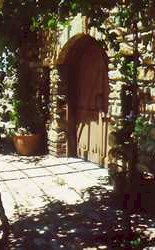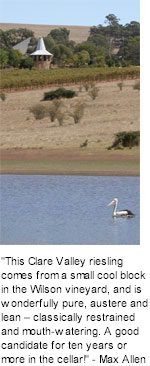


In 1973, John Wilson set out with soil map and sampling auger in search for the plot for his vines. The chosen land was some of the grazing slopes east of Sevenhill. The locals were bemused by this venture and were firm but kind with their advice about the unsuitability of the area for grapes. To that same handful of locals the little valley was known as Polish Hill River, a quaint tribute to its early pioneers. In 1980 the vineyard produced its first commercial wine and with that Shiraz-Cabernet, wine consumers were introduced to this hitherto unknown corner of Clare. By then no-one had any doubts about the ability of Polish Hill River to produce fine wine. The Wilson family has been content to expand its operation slowly and steadily and is unfussed that most who followed them now cultivate larger tracts.

The winery only processes estate-grown fruit. More than half of the production is Riesling and Cabernet Sauvignon, both of which are produced under the Gallery Series label, which features a different artist each year. Other wines include a Zinfandel, a fortified Traminer, Chardonnay, and Shiraz. Hippocrene is a distinctive sparkling red wine produced since 1990.
The Clare Valley whilst being a catchy marketing term, is in fact incorrect. There is no single valley, while there is a plateau corrugated by ridges that generally run in a north-south direction. The central feature of this plateau is Mount Horrocks (600 m). South of Mount Horrocks there are three valleys: the Wakefield River, Eyre Creek, and the Skillogalee Creek, that join and flow west to Port Wakefield.
Flowing north are the valleys of the Hill River and the Hutt River, that ultimately flow into the Broughton and meet the sea at Port Davis (between Port Broughton and Port Pirie). Polish Hill River is located on the upper reaches of the Hill River. The soil at Polish Hill River is an acidic red-brown clayey-loam. In contrast to the Watervale sub-region to the south of Mount Horrocks, there is no limestone at Polish Hill River. Geologically the region is of ancient shale and an extension of the famous Mintaro slate. (The slate quarry at nearby Mintaro remains the only site in Australia where it is possible to obtain a sheet of slate large enough for a full-size billiard table)

In the extreme north-west corner of the vineyard, and on the highest part of the property is a small 2 hectare planting of young riesling vines, that is known as the DJW block, so called because Daniel James Wilson planted the patch. In 2001 it yielded its first economic crop, and it was Daniel's choice that the wine should be kept separate from the rest of the Riesling production and produced as an individual vineyard bottling.
Daniel James Wilson's faith was justified, when in June 2002 the 2001 DJW Riesling was awarded the trophy for the best boutique riesling in the Boutique Wine Awards. That 2001 DJW Riesling also won a gold medal in the 2002 Clare Valley Wine Show category for non-commercial riesling. The 2003 vintage has continued the winning streak, and in the 2003 Clare Valley Wine Show was awarded the Mick Knappstein Trophy for the best commercial riesling (current vintage), and the Jim Barry Perpetual Trophy for the best wine of the show. In August 2004 this wine was awarded the top honour for riesling in the Tri-Nation awards, held in Sydney. This award judges the best wines submitted from South Africa, New Zealand, and Australia. The Wilson Vineyard Rieslings are powerful wines that take more than five years in the bottle to show their best, and have consistently shown themselves to be amongst the nation's best.
The Wilson Vineyard doesn't claim to have the best scenic outlook of the Clare wineries, but puts its hand up for second place. Wine tasting and sales are conducted in a stone-faced underground cellar that was constructed in 1988. This, and other associated winery buildings have used stone sourced on the property. There have been extensive plantings of trees, both native and exotic types around the cellar. For a touch of eccentricity, the sales area is decorated with pieces of railway memorabilia.
